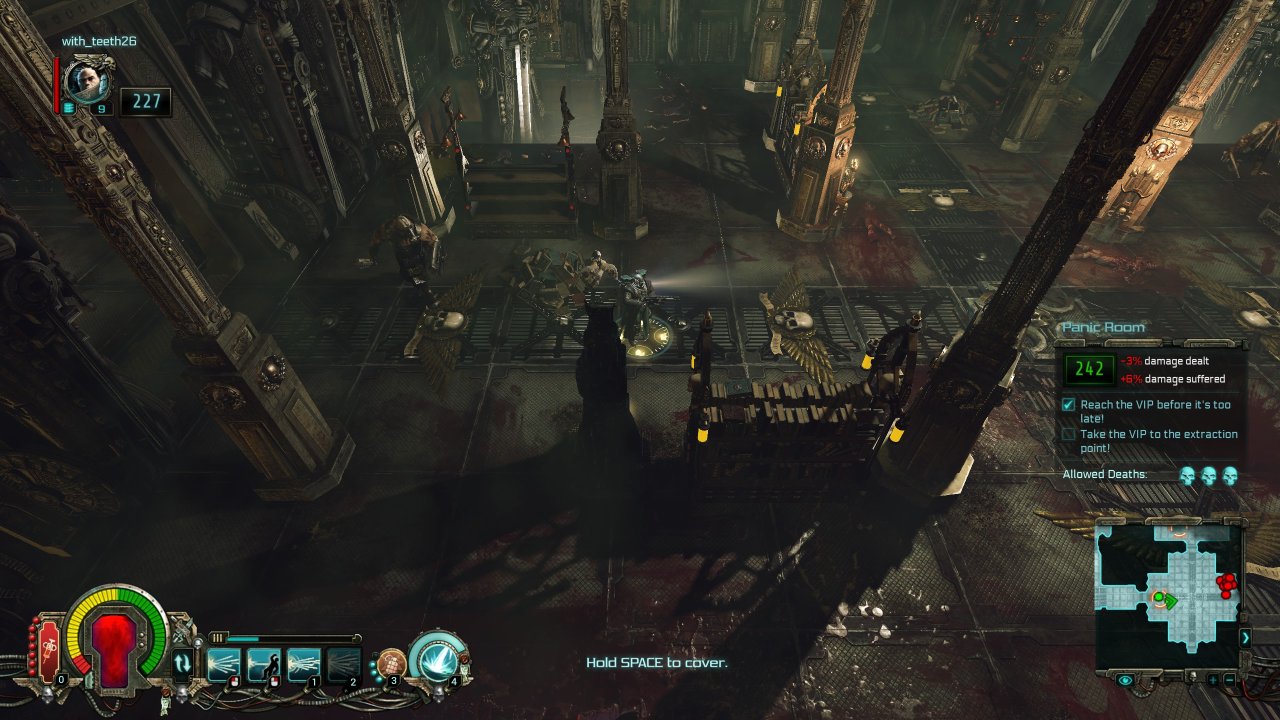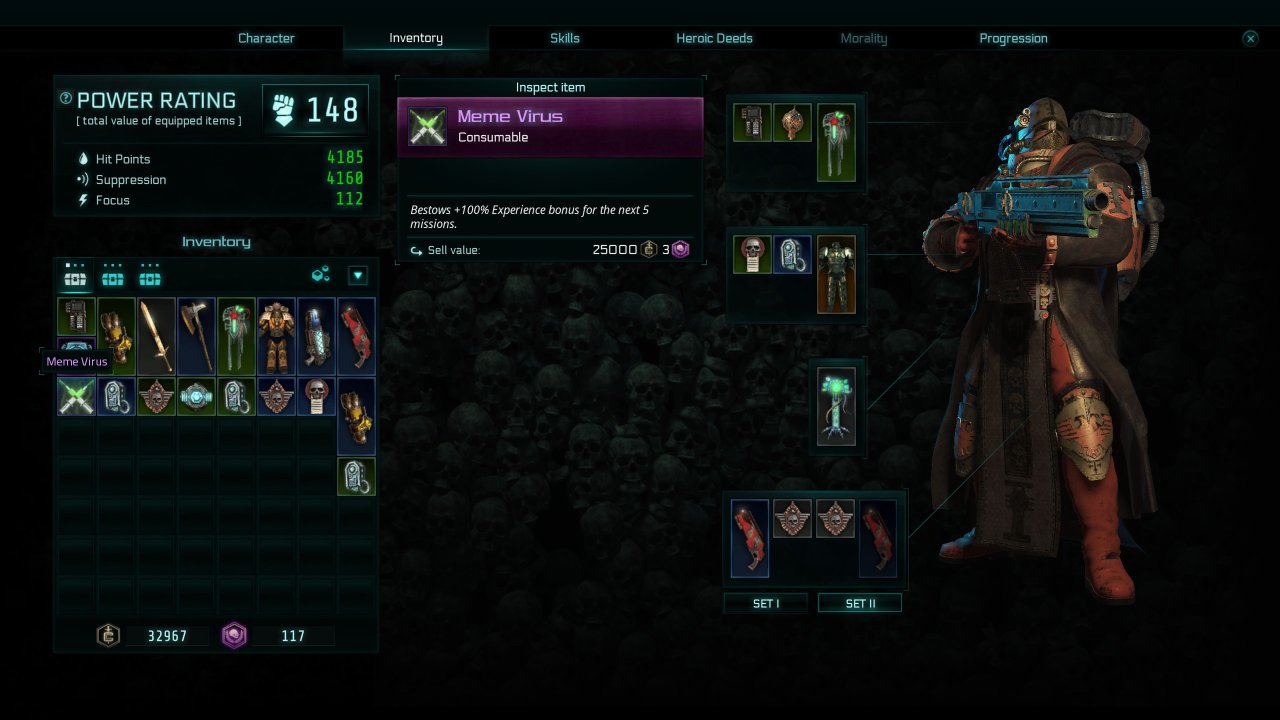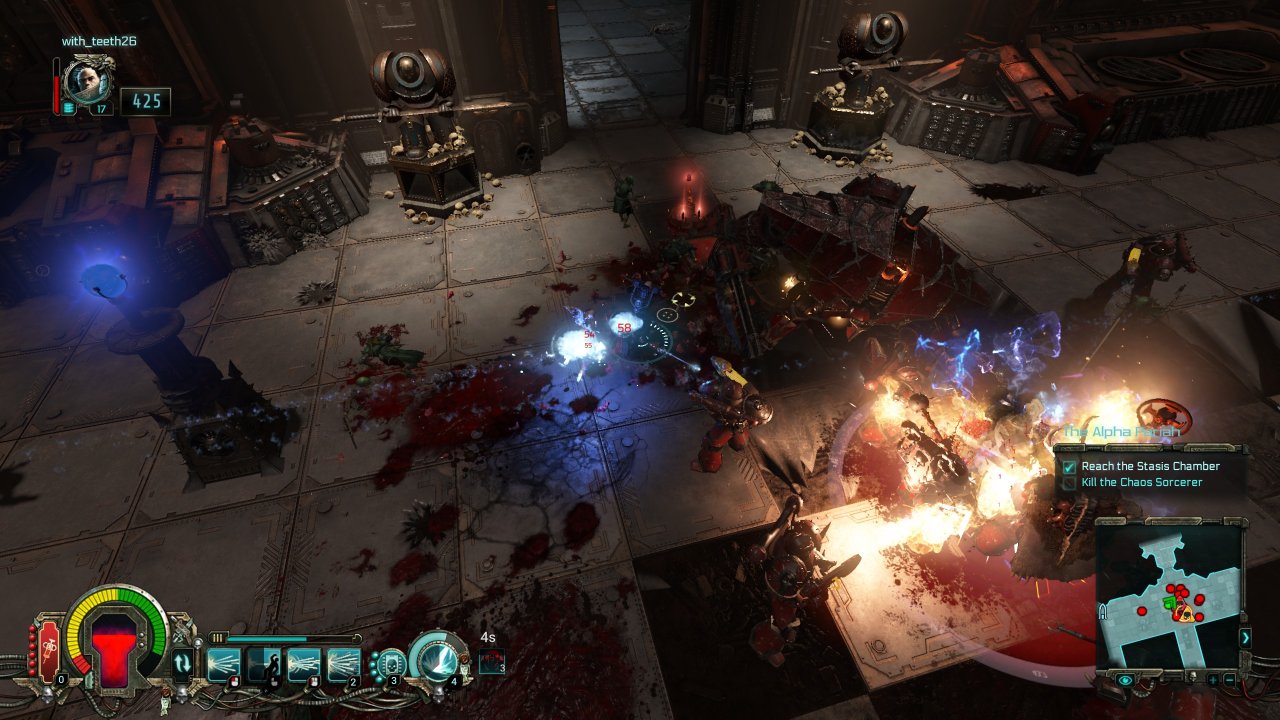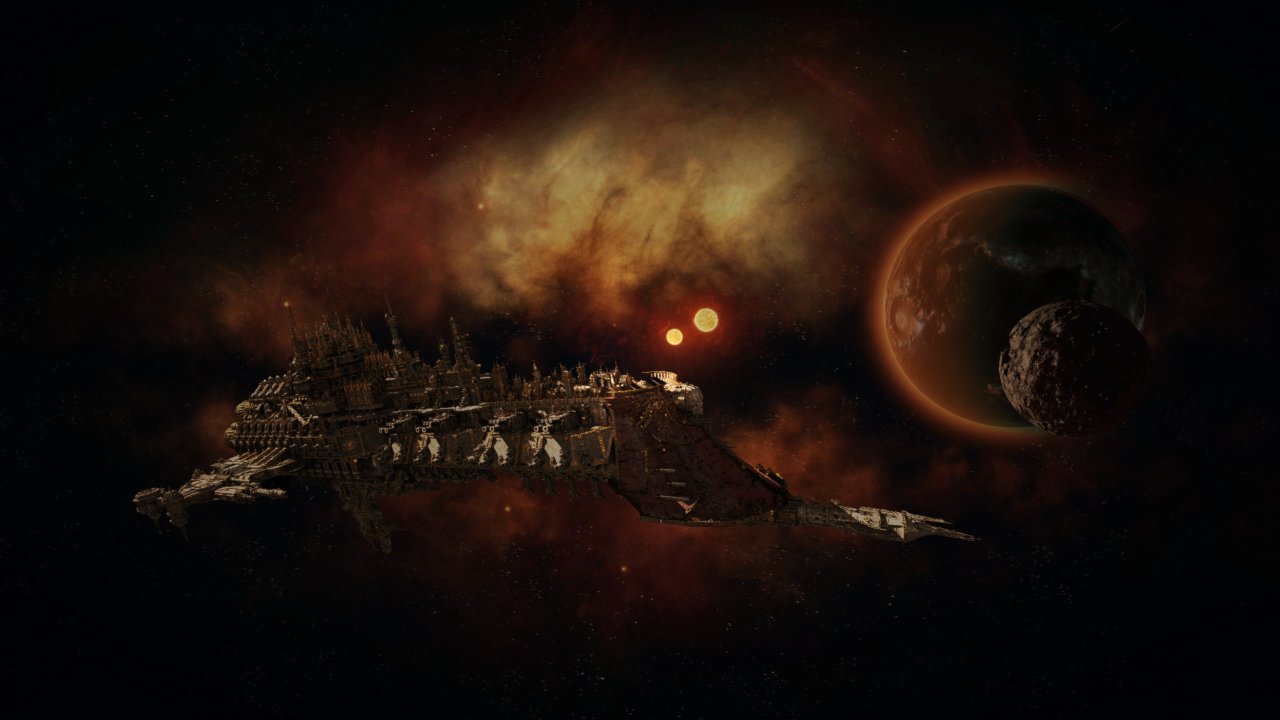Warhammer 40,000: Inquisitor - Martyr Review
A Martyr for a Worthy Cause
With the Warhammer license being thrown around like candy recently and the combination of squishy, horde-based races and powerful individual warriors that are so prominent in the universe, it was only a matter of time before we got a Diablo-style Warhammer action RPG. After honing their ARPG chops on the Van Helsing series, Neocore Games have stepped up to attempt just this, tackling the wacky science fantasy 40K variant of Warhammer with a number of fresh ideas and ambitious plans for the future of the game. Though some of these ideas do work, a number of significant design, gameplay and technical issues are also present that make it feel like the game would have greatly benefited from an extended stay in Early Access.

Perhaps the most notable thing that sets Warhammer 40K: Inquisitor – Martyr apart from other ARPGs is its structure, which is most reminiscent of Mass Effect. Rather than running around in an interconnected world as is typical for this genre, you have control of a large space vessel that you use to fly between galaxies and solar systems, with missions being self-contained and taking place on space ships, space stations and sometimes planet surfaces. You play as an Inquisitor, a sort of space-detective/warrior who goes around killing things and solving mysteries. The lengthy story involves the investigation of a mysterious ship you come across early in the game called the Martyr.
Though I felt my ability to follow the main storyline was hamstrung by my lack of knowledge of the Warhammer 40K Universe, it is clear that a lot more effort went into the narrative here than is typical for an ARPG. There is some strong writing and a good sense of mystery that gets created with some cool concepts such as a AI machine-god and intriguing religious and occult goings-on. There is even a sort of morality system, which goes up and down based on a few decisions you make throughout the campaign, which has some minor gameplay consequences.
The way the story is told is less impressive. Most of it is done through non-interactive conversations, either over the radio while you are running around on missions, or during cutscenes where the screen gets letter-boxed and the camera wobbles around overhead while characters talk. The voice-acting is done in a hammy, over-the-top style that while fitting for the universe, is extremely one-dimensional and quickly gets tiresome given how much dialogue there is. There are also some ridiculous moments where these cutscenes will trigger mid-mission, with your character talking over the radio while all nearby enemies stand still and politely wait for you to conclude the conversation. More effective are hand-written notes you might find on bodies of fallen enemies, or transcripts found on computer terminals.
The gameplay and design side of things similarly largely fail to hold up their end of the bargain. Perhaps the biggest issue is how the character progression and customization works. As is becoming standard in randomized loot-centric games, your character’s overall power is determined by an aggregate score of the items you have equipped, similar to Light in Destiny or your gear score in The Division, referred to here as your power rating. Each mission has a power rating that gets compared to the power rating of your character. If your character’s power rating is below that of the mission, there is a penalty to how much damage you take and how much damage you do. So for instance, if your character has a power rating of 90, and the mission has a suggested power rating of 100, you will take 10% more damage and deal 10% less damage. If these numbers are reversed, you gain a 10% damage bonus and take 10% less damage.

This is problematic because it means there is a strong incentive to simply equip whatever items you find that have the highest power rating, regardless of what other attributes that gear has. Equipping a set of items that balance and round out your character is a core component of ARPGs, but here it is mostly advantageous to simply look at the power ratings and equip whatever has the highest number for the most part. This power rating system is also used to gate progress through the story, as story missions climb steeply in their power requirements, forcing you to go off and grind on the generally tedious and repetitive randomly generated side missions in order to increase your power level. Fortunately, you can choose to play story missions in ‘story’ mode difficulty, which seems to just reduce the power requirements to a more reasonable level.
Another way in which Martyr deviates from most ARPGs is how character progression works. Once you pick one of three classes, all of your character abilities are tied to your weapons and armor. This is an interesting idea as it lets you swap between different sets of abilities quickly by changing your gear between missions. However, it also means that when you level up and gain skill points, you can only spend them on passive buffs like increased health, damage, speed etc. Again, figuring out a complimenting set of skills and abilities toward building an effective character is typically one of the most engaging aspects of this sub-genre, and there is almost none of that here. As a result, the combat doesn’t really get any deeper or more complex as you progress, you simply swap out weapons and gear for different pre-set groups of attacks.
Since you can equip two weapons at once, and select a special ‘super’ ability that is determined by your armor, it is helpful to put some thought in having weapons and a special ability that compliment each other. For example, you might want a long-range, high damage firearm and a shotgun or melee weapon for up close encounters. The combat system in Martyr is not without merit, mostly thanks to a solid arsenal of interesting ranged and melee weapons from the 40K universe and a good sense of weight to the action. The three classes you can choose from include the heavy-hitting and tanky Crusader, the faster and more agile Assassin who can dodge in and out of combat, and the wizard-equivalent Psyker who uses the Warp for magical type abilities. Each class also has three sub-classes that typically emphasise some trait such as increased durability, or a focus on ranged or melee combat.
Most of my time was spent with the Crusader, as I found the other two classes were a bit fragile and over-reliant on the finicky cover system. You can take cover behind some objects by holding the space bar, but where you can take cover sometimes seems arbitrarily limited. This problem is further compounded by the fact that most cover is destructible and doesn’t last long, and most fights involve some enemies that will swarm you at close range, or enemies who will lob grenades behind your cover, making its use quite limited. The Crusader’s toughness makes this class less reliant on the cover system which made it the most fun to play for me.

The game is at its best when you find a weapon or combination of weapons you like and wade into combat with a group of weaker enemies, with bodies flying and environments crumbling. I was particularly fond of the jump-jet special ability that lets you jump into the middle of a group of enemies, crushing them or knocking them down before letting loose with a shotgun or thunder-hammer which is every bit as entertaining as it sounds.
Another unique mechanic present in Martyr is the suppression meter that both yourself and enemies have. Your suppression resistance is depicted by a bar surrounding your health. When you take ranged fire in particular, this bar gets depleted, and you can eventually become suppressed and overwhelmed. As you get suppressed, you move slower and become more susceptible to attacks that knock you down or stun you, though the same applies for your enemies, so using attacks that whittle down the suppression resistance of tougher enemies is an effective strategy. It also forces you to make some interesting choices about your priorities in combat. You have access to something called inoculators, which can quickly restore health, suppression resistance or boost damage. The catch is you can only bring one type of inoculator into each mission, forcing you to decide what is most important.
Though the combat can certainly be satisfying, there are a few problems in addition to the wonky cover system that can spoil your fun. Perhaps most frustrating is how unresponsive the controls can feel at times. Sometimes pressing the buttons to switch weapons or throw grenades simply don’t seem to do anything, or seem to get canceled if you press the weapon-switch button then press the attack button before the weapon swap gets completed. Some weapon attacks have cool-downs, and the cooldown timers restart when you swap weapons which also hurts the flow of combat, since there are a lot of situations where it makes sense to start out with a ranged weapon then switched to a close-range one once enemies swarm you, or you want to quickly swap from a close-range weapon to a long range one after you deal with melee-focused enemies and want to start picking off those attacking you from range.
Some enemies are also absolute bullet sponges, with some fights just devolving into you standing around whittling down their health bar, occasionally using the inoculator for health, until they finally die. Some mission types can also be frustrating, such as defensive missions and those that ask you to escort AI companions who are liable to get killed and force a mission restart. The rare vehicle missions also felt pretty underwhelming due to the slow-moving nature of the vehicles and limited number of abilities. I also encountered a few mission scripting errors where the game didn’t recognize when I completed an objective, forcing mission restarts on a few occasions.

Combat can also be hurt by performance issues that crop up pretty regularly. The game requires a constant online connection, and it seems like the servers are being pinged pretty regularly for certain things. At times, even when I had a good frame rate, enemy animations seemed jittery and they even rubber-banded around occasionally, making it seem like the enemies are handled server-side even when playing solo. This is even more noticeable in the multiplayer, where you can matchmake with friends or random players to take on a randomly generated mission as four-person team. Most of these missions that I attempted had absolutely ruinous lag that made them pretty much unplayable. The PvP mode fares a bit better in terms of performance, but the game mechanics aren’t terribly well suited to PvP and I didn’t get much enjoyment out of this mode.
Fortunately, there is one thing that Martyr nails: the Warhammer 40K aesthetic. The game looks very good, with a solid range of gloomy environments rendered in great detail, though many of the industrial-looking space hulk interiors start to look the same after a while. Destructible objects that blow apart during frantic moments of combat make it feel like you really are using some ridiculously powerful weapons. Though most of the performance issues seem tied to the always-online connection, I found the frame rate did struggle in some of the more visually busy levels. The audio is generally fantastic with weapons sounding distinct and powerful, and a moody soundtrack that fits the setting perfectly.
Somewhere in the jumbled mess of ideas and technical issues that is Warhammer 40K: Inquisitor – Martyr, there is a really cool and unique action RPG. The combat can be visceral and satisfying, and it depicts the bizarre science fantasy universe with impressive detail and engrossing atmosphere. It is a shame then that so many ideas and mechanics feel under-developed or superfluous, and that the gameplay and progression design leads to so much tedium and grinding instead of the flexible character building it is so clearly striving for. If Neocore continue to work on the game post-launch, in six months or a year it could well be worth playing for Warhammer 40K and ARPG fans alike.
 Comments
Comments



















